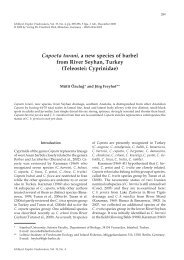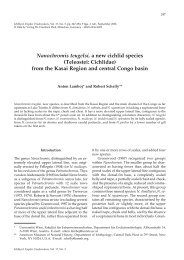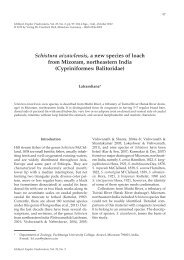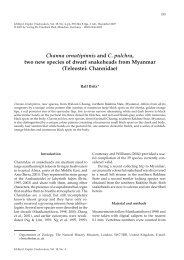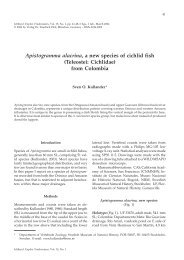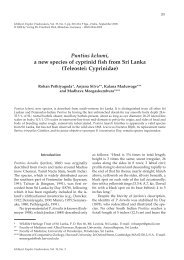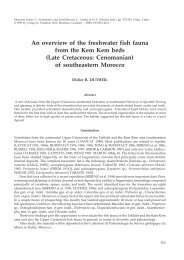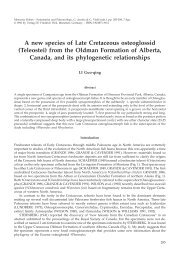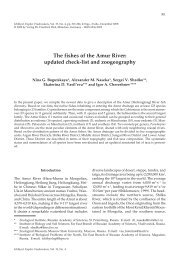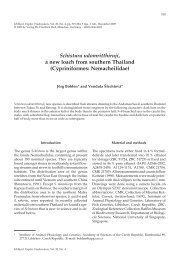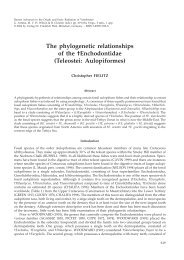A synopsis of the South Asian fishes referred to Puntius - Verlag Dr ...
A synopsis of the South Asian fishes referred to Puntius - Verlag Dr ...
A synopsis of the South Asian fishes referred to Puntius - Verlag Dr ...
Create successful ePaper yourself
Turn your PDF publications into a flip-book with our unique Google optimized e-Paper software.
78<br />
less than eye diameter; rostral barbel shorter,<br />
about half length <strong>of</strong> maxillary barbel.<br />
Pelvic-fin origin slightly anterior <strong>to</strong> dorsal-fin<br />
origin. Posterior margins <strong>of</strong> dorsal and anal fins<br />
concave. Distal margins <strong>of</strong> pec<strong>to</strong>ral and pelvic<br />
fins convex, rounded. Dorsal-fin origin above 11th<br />
lateral-line scale. Dorsal fin with 4 unbranched<br />
and 8 branched rays, last unbranched ray stiff,<br />
strongly serrated posteriorly in its proximal twothirds,<br />
weak, segmented in its distal one-third.<br />
Last unbranched dorsal-fin ray longest, when<br />
adpressed not overlapping tip <strong>of</strong> last branched<br />
dorsal-fin ray. Anal fin with 3 unbranched and 5<br />
branched rays. Pelvic fin with 1 unbranched and<br />
8 branched rays. Pec<strong>to</strong>ral fin with 1 unbranched<br />
and 15 branched rays. Caudal fin forked, lobes<br />
<strong>of</strong> equal length, longest rays about twice as long<br />
as median ones. Caudal fin with 8 upper and 7<br />
lower procurrent rays, and 1 + 9 + 8 + 1 principal<br />
rays.<br />
Table 4. Standard length (in millimetres) and proportional<br />
measurements as a percentage <strong>of</strong> standard length<br />
or head length <strong>of</strong> <strong>the</strong> neotype (AMS B.7920) and a <strong>to</strong>potype<br />
(AMS B.7921) <strong>of</strong> Sys<strong>to</strong>mus immaculatus.<br />
B.7920 B.7921<br />
Standard length (mm) 186.0 192.7<br />
Percent standard length<br />
Total length 127 –<br />
Head length 26.1 25.4<br />
Predorsal length 53.2 54.2<br />
Pre-anal length 75.1 72.1<br />
Pre-pelvic length 41.0 48.2<br />
Caudal-peduncle length 19.4 22.3<br />
Caudal-peduncle depth 15.2 14.8<br />
Body depth 35.9 35.6<br />
Dorsal-fin height 22.7 20.4<br />
Length <strong>of</strong> stiff portion <strong>of</strong> last 15.6 14.7<br />
unbranched dorsal-fin ray<br />
Pec<strong>to</strong>ral-fin length 19.2 19.3<br />
Pelvic-fin length 19.7 18.8<br />
Dorsal-hypural distance 55.4 56.4<br />
Post-dorsal distance 38.8 40.1<br />
Maximum body width<br />
Percent head length<br />
15.4 14.5<br />
Snout length 30.1 29.5<br />
Post-orbital head length 53.6 52.2<br />
Head depth 83.1 81.0<br />
Eye diameter 23.0 22.3<br />
Maxillary barbel length 19.3 23.8<br />
Rostral barbel length 8.3 16.8<br />
Internarial width 23.0 23.5<br />
Interorbital width 43.8 42.8<br />
Lateral line present, complete, with 32 (33)<br />
pored scales on body, 2 (3) on caudal-fin base.<br />
Lateral line sloping gently downwards for about<br />
7 scales, level <strong>the</strong>reafter. Flank scales large, <strong>the</strong>ir<br />
central field (middle one-third) free <strong>of</strong> annuli,<br />
with about 15 irregular polygons. Radii radial,<br />
denser anteriorly and posteriorly, less dense in<br />
dorsal and ventral fields. 5 1 /2 scales in transverse<br />
line between lateral line and origin <strong>of</strong> dorsal fin,<br />
4 between lateral line and origin <strong>of</strong> pelvic fin;<br />
1 /2 3/1/3 scales in transverse line on caudal peduncle;<br />
12 (13) predorsal scales. An axillary scale<br />
approximately one-fourth length <strong>of</strong> pelvic fin<br />
extends backwards from pelvic-fin origin.<br />
Supraneurals 5 (6); 15 abdominal and 17 (18)<br />
caudal vertebrae (Fig. 6b); free uroneural present;<br />
infraorbital 3 slender.<br />
<strong>Dr</strong>avidia, new genus<br />
Type species. Cirrhinus fasciatus Jerdon, 1849:<br />
305.<br />
Diagnosis. <strong>Dr</strong>avidia differs from all o<strong>the</strong>r <strong>South</strong><br />
and Sou<strong>the</strong>ast <strong>Asian</strong> genera <strong>of</strong> Cyprinidae by <strong>the</strong><br />
combination <strong>of</strong> <strong>the</strong> following characters and<br />
character states: size small, usually less than<br />
60 mm SL; rostral and maxillary barbels present;<br />
lateral line complete, with 18-26 pored scales on<br />
body; dorsal fin with 4 unbranched and 8 branched<br />
rays, <strong>the</strong> last unbranched ray weak, smooth<br />
(Fig. 7c); anal fin with 3 unbranched and 5<br />
branched rays; gill rakers simple, acuminate (not<br />
branched or laminate); no antrorse predorsal<br />
spinous ray; infraorbital 3 deep, partly overlapping<br />
preoperculum (Fig. 7a); free uroneural and<br />
post-epiphysial fontanelle absent (Fig. 7 b, d); and<br />
one or two broad, black bars on flank, between<br />
bases <strong>of</strong> dorsal and anal fins.<br />
Remarks. The following nominal species are<br />
<strong>referred</strong> <strong>to</strong> <strong>Dr</strong>avidia: D. afasciata (Jayaram, 1990),<br />
D. fasciata (Jerdon, 1849), D. kannikattiensis (Arunachalam<br />
& Johnson, 2003), D. melanampyx (Day,<br />
1865) and D. pradhani (Tilak, 1973).<br />
Etymology. Named for <strong>the</strong> <strong>Dr</strong>avidian peoples <strong>of</strong><br />
<strong>the</strong> sou<strong>the</strong>rn peninsular India; gender feminine.<br />
Pethiyagoda et al.: Synopsis <strong>of</strong> <strong>South</strong> <strong>Asian</strong> <strong>Puntius</strong>





